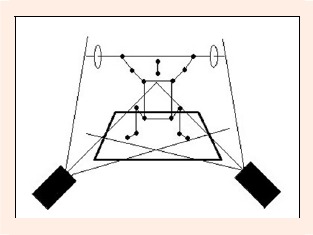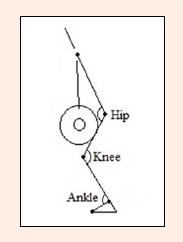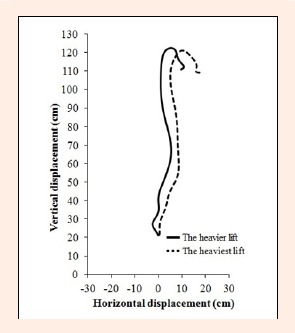Abstract
The purpose of the study was to compare the linear kinematics of the barbell and the angular kinematics of the lower limb during the snatch lifts of two different barbell weights in elite male adolescent weightlifters. In the national team level, nine elite male adolescent weightlifters participated in the study. The snatch lifts were recorded by two video cameras under competitive conditions in preparation period before the European Junior Championship (Sony MiniDv PAL- 50 field/s) and the two heaviest successful lifts were selected for kinematic analysis. The little toe, ankle, knee, hip, and shoulder on the body and one point on the barbell were digitized using Ariel Performance Analysis System (APAS, San Diego, CA, USA). Significant decreases were found in the maximum barbell height, the relative power output during the second pull, and the maximum vertical velocity of the barbell during the second pull of the heaviest lift (p < 0.05). Maximum extension velocity of the hip joint significantly increased during the first pull of the heaviest lift (p < 0.05). As the mass of the barbell increased, the maximum vertical velocity and the maximum height of the barbell and relative power output during the second pull decreased in the heaviest lift performed by adolescent weightlifters. Coaches should pay attention to assistant exercises to increase explosive strength during the second pull with maximum strength in male adolescent weightlifters.
Key points.
The results demonstrate that the maximum strength of the extensor muscles of the hip during the first pull and their explosive strength during the second pull must be improved.
Coaches should pay attention to assistant exercises to increase explosive strength during the second pull with maximum strength in male adolescent weightlifters.
Key words: Load of barbell, junior weightlifters, angular kinematic
Introduction
The snatch is the most technical component of a weightlifting competition (Gourgoulis et al., 2000). The snatch technique requires the barbell to be lifted from the floor to a straight-arm overhead position in one continuous motion (Burdett, 1982; Gourgoulis et al., 2000). Many factors can influence the outcome of a snatch attempt. Therefore, whatever determines success is likely to be multifactorial in nature (Stone et al., 1998). The primary factors that affect the success of weightlifters in the snatch technique of weightlifting are explosive strength, flexibility, and as well as technique (Enoka, 1979; Garhammer, 1985; 1991; Gourgoulis et al., 2000; Isaka et al., 1996; Ikeda et al., 2012; Schilling et al., 2002; Stone et al., 1998).
There are currently many studies available in literature that examined the kinematics of the snatch technique in elite male (Baumann et al., 1988; Garhammer, 1985; Gourgoulis et al., 2000; 2002; Harbili, 2012; Isaka et al., 1996) and female weightlifters (Akkus, 2012; Garhammer, 1991; Gourgoulis et al., 2002; Hoover et al., 2006; Ikeda et al., 2012). However, few studies have focused on the barbell energetics, its kinematics and the angular kinematics of the limb during the snatch in adolescent (Gourgoulis et al., 2004) and elite male junior weightlifters (Campos et al., 2006). Previously published data for snatch and clean pulls of adult weightlifters revealed that as the weight lifted increases, the duration of the pull also increases, but the maximum and average pull velocities, maximum barbell height, and power outputs decrease (Garhammer, 1985; 1993). Garhammer (2001) reported that a small decrease in weight, about 5%, could often increase power output substantially because of a considerably greater movement speed and shorter time interval for the completion of the lift. In addition, in a recent study, it was revealed that the vertical and horizontal kinematics of the barbell and body decreased at the pull phase of the snatch technique as the barbell load increased. The power output during the second pull increased although the work done did not change, whereas work and power output increased during the first pull depending on the increase in the barbell weight (Hadi et al., 2012). Gourgoulis et al. (2004) reported that adult male lifters are superior to adolescent lifters from the perspective of relative power output during the snatch lifting and that adolescent lifters are less skillful than adult lifters in the second pull phase, which is the power phase of the snatch technique. It was also reported that the barbell trajectories varied greatly in the snatch lifts of elite male junior lifters of different weight and that lifters belonging to heavier categories were more efficient, as they managed to have longer barbell propulsion trajectories (Campos et al., 2006).
The analysis of the snatch technique performed by adolescent lifters is extremely interesting due to the fact that the weightlifters are in initial phase of high performance (Campos et al., 2006). Therefore, determining the effects of the increased barbell load on the snatch technique in adolescent weightlifters is especially important to manipulate training in order to help them lift heavier loads. Thus, training programs specifically designed to improve the strength and technical competence of lifters at this age could lead to better preparation of the adolescents for not only their current but also adulthood performance. For this reason, during the snatch lift of junior lifters, it is possible that the barbell weight will affect the linear movement of the barbell and the angular kinematics of joints. The objective of the study was to compare the linear kinematics of the barbell and the angular kinematics of the lower limb during the snatch lifts of two different barbell weights in elite male junior weightlifters.
Methods
Subjects
Nine elite male adolescent weightlifters at national team level (age: 18.89 ± 0.78 years, height: 1.70 ± 0.07 m; body mass: 73.76 ± 16.77 kg, training age: 5.46 ± 0.78 years) participated in the study (Table 1).
Table 1.
Characteristics of male junior weightlifters and barbell.
| Subjects | Age (y) |
Height (m) |
Body mass (kg) | Weight category (kg) |
Barbell mass (kg) | |
|---|---|---|---|---|---|---|
| Heavier lift | The heaviest lift | |||||
| 1 | 20 | 1.57 | 55.6 | 56 | 85 | 90 |
| 2 | 18 | 1.65 | 61.9 | 62 | 110 | 115 |
| 3 | 18 | 1.73 | 61.6 | 62 | 115 | 118 |
| 4 | 19 | 1.69 | 68.2 | 69 | 125 | 130 |
| 5 | 19 | 1.70 | 68.8 | 69 | 130 | 133 |
| 6 | 18 | 1.70 | 68.5 | 69 | 130 | 135 |
| 7 | 19 | 1.70 | 84.7 | 85 | 140 | 143 |
| 8 | 20 | 1.80 | 84.5 | 85 | 140 | 145 |
| 9 | 19 | 1.80 | 110.0 | +105 | 130 | 135 |
All weightlifters were members of the national team and seven of them participated in the 36th Men's World Junior Championships and European Junior Championships in 2010. This study was conducted in accordance with the guidelines set forth by the Institutional Review Board of Selcuk University. All participants signed informed consent forms approved by the University Ethics Committee.
Experimental design
The three snatch lifts performed under competitive conditions by national adolescent weightlifters who were preparing for European Junior Championship were analyzed to determine the linear kinematics of the barbell and the angular kinematics of the lower limb. Each weightlifter recovered for 1-min between snatch attempts. The heaviest two successful snatch lifts of the three lift attempts of each subject were chosen for kinematic analysis.
Procedures
Two digital cameras were positioned on the diagonal line of the platform at a distance of 7 m from the lifting area, forming an approximately 45° angle with the sagittal plane of the weightlifters (Figure 1). The snatch lifts were recorded using 2 digital cameras (Sony DCR-TRV18E, Tokyo, Japan), which captured images at 50 fields per second. The lift-off of the barbell was used to synchronize the 2 cameras.
Figure 1.

Experimental setup.
To determine the 3-dimensional kinematic data of the barbell and the angular kinematics of the hip, knee, and ankle joints during the snatch lifts, 1 point on the barbell and 5 points on the body were digitized using the Ariel Performance Analysis System (APAS, San Diego, CA, USA). The digitized points included the little toe, ankle, knee, hip, and shoulder on the left side of the body. In addition to these points, the digitized point on the barbell was located on the medial side of the left hand (Figure 2). A rectangular cube with a length of 2.50 m, a depth of 1.00 m, and a height of 1.80 m was used to calibrate the movement space. The 3-dimensional spatial coordinates of the selected points were calculated using the direct linear transformation procedure with 12 control points. The calibration cube was placed on the platform before the lifting, recorded, and then removed. The raw position and time data were smoothed using a lowpass digital filter. Based on the residual analysis, a cut-off frequency of 4 Hz was selected (Garhammer and Whiting, 1989). The mean reconstruction errors described in root-mean-square (RMS) values were 0.54, 0.34, and 0.59 mm for the X, Y, and Z directions, respectively.
Figure 2.

The digitized points and definition of the joint angles.
The 6 phases of the snatch lift were determined according to the change in direction of the knee angle and the height of the barbell (Baumann et al., 1988; Gourgoulis et al., 2000; Häkkinen et al., 1984). In this study, the first 5 phases of the snatch technique were studied from the first pull to the catch phase (Table 2).
Table 2.
The first 5 phases of the snatch technique.
| The phases of the snatch | Commentary |
|---|---|
| The first pull | From the barbell lift-off until the first maximum knee extension. |
| The transition phase | From the first maximum knee extension until the first maximum knee flexion. |
| The second pull | From the first maximum knee flexion until the second maximum extension of the knee. |
| The turnover under the barbell | From the second maximum extension of the knee until the achievement of the maximum height of the barbell. |
| The catch phase | From the achievement of the maximum height of the barbell until stabilization in the catch position. |
The vertical work (W) performed on the barbell during the first and second pull was calculated from changes in the barbell’s mechanical energy. Mechanical energy is the sum of the barbell’s kinetic (KE) and potential energy (PE), where KE = mv2/2 and PE = mgh, with m being the mass of the barbell, v its velocity, h its height, and g the acceleration of gravity. Power applied to the barbell was calculated by dividing work done during each phase by its duration (Garhammer, 1993). Calculated power outputs only included the vertical work done by lifting the barbell. The relative work and power output values were calculated relative to the body mass.
Statistical analysis
Descriptive statistics (mean ± SD) were calculated for all the variables. The hypotheses of normality and homogeneity of the variance were analyzed via Kolmogorov-Smirnov and Levene tests, respectively. The t-test for dependent samples was used to analyze the kinematic differences between the snatch lifts. The kinematic variables of the snatch lifts were compared for lift (the heavier lift-the heaviest lift), phase (the first pull-the second pull), and joint (the ankle-the knee-the hip joints) factors. The linear kinematic variables of the barbell were analyzed using lift x phase repeated-measures analysis of variance (ANOVA). The angular kinematics of the lower limb was analyzed using joint x lift repeated-measures ANOVA. Bonferroni post hoc tests were used to assess significant differences. Effect size (η2) and statistical power analysis values were used to interpret the magnitude of main and interaction effects. As an effect size, Cohen’s d was of ≥0.2 and <0.5 as small, ≥0.5 and <0.8 as medium, and ≥ 0.8 as large (Cohen, 1988). All statistical analyses were performed using the Statistical Package for Social Science version 18.0 (SPSS, Chicago, IL, USA). The level of significance was set at p < 0.05.
Results
The characteristics of the adolescent weightlifters and their snatch lifts are presented in Table 1.
When the mean mass of the barbell that was lifted by the junior weightlifters was compared, it was observed that the mean barbell mass in the heaviest lift was significantly greater than that of the heavier lift (Table 3). The maximum barbell height was significantly lower in the heaviest snatch lift than that of the heavier lift (p < 0.05, Figure 3). A significant phase x lift interaction effect (F(1,16) = 4.74, p < 0.05, η2 = 0.23, power = 0.54) was found for the vertical velocity of the barbell. The vertical velocity of the barbell was significantly less in the second pull of the heaviest snatch lift than that of the heavier lift (Table 3).
Table 3.
Linear vertical kinematics of the barbell during the first and the second pull. Data are means (±SD).
| Variables | Heavier lift | The heaviest lift |
|---|---|---|
| Barbell mass (kg) | 122.2 (16.8) | 126.8 (16.8) * |
| Barbell height at the end of the first pull (m) | .56 (.06) | .56 (.06) |
| Barbell height at the end of the second pull (m) | .99 (.02) | .99 (.02) |
| Maximum barbell height (m) | 1.27 (.06) | 1.25 (.06) * |
| The maximum vertical velocity of the barbell in the first pull (m·s-1) | .98 (.21) | .95 (.22) |
| The maximum vertical velocity of the barbell in the second pull (m·s-1) | 1.82 (.12) | 1.72 (.13) * |
| Horizontal displacement toward weightlifter in the first pull (m) | .06 (.03) | .06 (.02) |
| Horizontal displacement away from weightlifter in the second pull (m) | .04 (.03) | .04 (.05) |
* p < 0.05
Figure 3.

Barbell trajectory of the heavier snatch lift (130 kg) and the heaviest snatch lift (133 kg) of junior weightlifter in 69-kg weight category.
No significant interaction was found between the snatch lifts in the absolute mechanical work and power output. However, a significant interaction phase x lift (F(1,16) = 9.04, p < 0.05, η2 = 0.36, power = 0.81) was found for the relative power output (Table 4). The relative power output during the second pull was significantly lower in the heaviest lift than that of the heavier lift (p < 0.05).
Table 4.
Absolute and relative work and power output values during the first and the second pull. Data are means (±SD).
| Variables | Heavier lift | The heaviest lift |
|---|---|---|
| Absolute work in the first pull (J) | 456 (133) | 470 (132) |
| Relative work in the first pull (J·kg-1) | 3.7 (.7) | 3.6 (.6) |
| Absolute work in the second pull (J) | 386 (71) | 352 (56) |
| Relative work in the second pull (J·kg-1) | 3.2 (.5) | 2.8 (.3) |
| Absolute power output in the first pull (W) | 707 (198) | 754 (227) |
| Relative power output in the first pull (W·kg-1) | 5.8 (1.2) | 5.9 (1.3) |
| Absolute power output in the second pull (W) | 2240 (355) | 2203 (381) |
| Relative power output in the second pull (W·kg-1) | 18.3 (1.6) | 17.3 (1.8) * |
* p < 0.05
There was a significant joint x lift interaction (F(2,24) = 4.52, p < 0.05, η2 = 0.27, power = 0.72) during the first pull in the angular velocity of the joints (Table 5). The maximum angular velocity of the hip joint during the first pull was significantly greater in the heaviest lift than that of the heavier lift (p < 0.05).
Table 5.
Angular kinematics of the ankle, knee and hip joints during the first and the second pull. Data are means (±SD).
| Variables | Heavier lift | The heaviest lift |
|---|---|---|
| First pull | ||
| Maximum ankle extension angle (°) | 126.2 (3.2) | 128.0 (3.5) |
| Maximum knee extension angle (°) | 144.7 (7.0) | 148.1 (6.4) |
| Maximum hip extension angle (°) | 93.2 (8.3) | 96.9 (8.5) |
| Maximum ankle angular velocity (°·s-1) | 100.9 (25.7) | 101.8 (30.1) |
| Maximum knee angular velocity (°·s-1) | 247.7 (48.2) | 226.4 (36.3) |
| Maximum hip angular velocity (°·s-1) | 158.1 (39.9) | 179.8 (37.5) * |
| Second pull | ||
| Maximum ankle extension angle (°) | 133.8 (5.6) | 136.4 (4.2) |
| Maximum knee extension angle (°) | 165.2 (4.3) | 165.6 (5.9) |
| Maximum hip extension angle (°) | 199.2 (4.5) | 200.4 (3.2) |
| Maximum ankle angular velocity (°·s-1) | 214.4 (61.1) | 219.1 (31.2) |
| Maximum knee angular velocity (°·s-1) | 279.7 (51.2) | 291.2 (51.9) |
| Maximum hip angular velocity (°·s-1) | 447.4 (46.5) | 415.8 (65.8) |
0 degree indicates the full flexion of the joint.
* p < 0.05
Discussion
It was reported in previous studies that barbell trajectories could be an indicator of the effectiveness of the snatch pull and the efficiency of the technique applied (Bartonietz, 1996; Bruenger et al., 2007; Garhammer, 1985). In snatch technique, the amount of horizontal displacement of the barbell, its maximum height and vertical velocity are important kinematic factors impacting performance. In the present study, approximately 5 kg`s increase in the mass of the barbell caused a decrease in the vertical velocity of the barbell and in the relative power output during the second pull and its maximum height. However, no significant differences were observed in other kinematics. The loss in vertical linear velocity of the barbell during the transition between the first and the second pull phase must be minimized in order to prevent the negative momentum of the barbell, an indicator of better weightlifters (Baumann et al., 1988; Gourgoulis et al., 2009). On the other hand, in the present study, no significant difference was observed in the horizontal displacement of the barbell between two snatch lifts. The amount of the horizontal displacement of the barbell was similar to that reported in the literature. Isaka et al. (1996) have reported that the barbell should move along the vertical reference line with a minimal horizontal displacement in order to reduce the horizontal work for an effective lifting technique. The excessive horizontal displacement of the barbell has negative effect on maximum vertical force production, and a little amount of horizontal displacement is a necessary condition for the body to use its lever systems (Hoover et al., 2006; Stone et al., 1998). Therefore, the horizontal movement of the barbell during the pull phase should be considered as an effective application of muscle power and reasonable estimate of movement in elite lifters who utilize extensors to contribute to the movement (Isaka et al., 1996).
In the present study, an increase in the barbell mass did not affect any absolute mechanical work and power output during the first or the second pull, except for the relative power output in the second pull. In the scientific literature, it has been reported that the first phase of the total pull is relatively slow and can be considered strength oriented, while the second pull is faster and can be considered more power oriented (Garhammer, 1980; 1991; 1993; Gourgoulis et al., 2000; 2002; 2004; 2009). The transition phase allows the storage of elastic energy into the extensor muscles during the flexion of the knees and its use during the following concentric contraction of the knees, resulting in an explosive power output during the second pull (Gourgoulis et al., 2009). The adolescents are characterized from a high level of snatch technique and differentiated from the adults predominantly at the less powerful execution of the movement (Gourgoulis et al., 2004).
In lifting, the extensor muscles about the ankle, knee and hip joints contribute to the control of antagonistic muscles in a sequence progressing from the hip to the ankle. This sequence is related to the sequence of the three phases of the pull during this lifting task (Isaka et al., 1996). In the present study, in regard to the joint velocities, the extension velocity of the hip joint showed a significant increase during the first pull. In adult weightlifters, hip joint is the first joint to reach its maximal extension velocity during the second pull. Then the knee and ankle joints reach their maximum extension velocities, respectively (Gourgoulis et al., 2000). In the present study, the increased extension velocity of the hip joint during the first pull in the heaviest lift was indicative of the fact that there was a greater need for the extensor muscles of the hip to overcome the inertia of the barbell and that the extensor power of the hip was important during the first pull in adolescent weightlifters. For a properly performed snatch lift, the knee extension should be faster in the second pull than during the first pull, and the hip extension velocity should be greater than the corresponding velocity of the knees (Baumann et al., 1988; Gourgoulis et al., 2009). On the other hand, the decrease in the extension velocity of the hip due to increased barbell mass during the second pull affected the explosive power needed in that phase and led to a decrease in the velocity and height of the barbell. For this reason, coaches should pay more attention to exercises which will develop maximum strength in the first pull and explosive force during the second pull in adolescent male weightlifters.
Conclusion
It was found in this study that a 5-kg increase in the barbell weight increased the contribution of the hip joint to the strength generated during the first pull in male adolescent weightlifters. As a result, as the barbell weight increases, explosive strength during the second pull will accordingly decrease. In addition, it has been reported in literature that adolescent lifters are less skillful than adult lifters in the second pull. Trainers should focus adolescent weightlifters on exercises suitable to the strength characteristics of the first and second pull. The maximum strength of the extensor muscles of the hip and knee during the first pull and the explosive strength of the extensor muscles of the hip and ankle during the second pull must be improved. Strengthening the extensor muscles of the ankle, knee and hip in adolescents might eradicate the need for the extensor muscles of the hip during the first pull, thereby increasing the explosive strength during the second pull.
Biographies

Erbil HARBİLİ
Employment
Assoc. Prof. School of Physical Education and Sports, University of Selcuk, Konya, Turkey
Degree
PhD
Research interests
Sport biomechanics, training sciences
E-mail: eharbili@selcuk.edu.tr

Ahmet ALPTEKİN
Employment
Assist. Prof. School of Sport Sciences and Technology, University of Pamukkale, Denizli, Turkey
Degree
PhD
Research interests
Sport biomechanics, training sciences
E-mail: aalptekin@pau.edu.tr
References
- Akkus H. (2012) Kinematic analysis of the snatch lift with elite female weightlifters during the 2010 World Weightlifting Championship. Journal of Strength and Conditioning Research 26, 897-905 [DOI] [PubMed] [Google Scholar]
- Bartonietz K.E. (1996) Biomechanics of the snatch: Toward a higher training efficiency. National Strength & Conditioning Association Journal 18, 24-31 [Google Scholar]
- Baumann W., Gross V., Quade K., Galbierz P., Schwirtz A. (1988) The snatch technique of world class weightlifters at the 1985 world championships. International Journal of Sport Biomechanics 4, 68-89 [Google Scholar]
- Bruenger A.J., Smith S.L., Sands W.A., Leigh M.R. (2007) Validation of instrumentation to monitor dynamic performance of Olympic weightlifters. Journal of Strength and Conditioning Research 21, 492-499 [DOI] [PubMed] [Google Scholar]
- Burdett R.G. (1982) Biomechanics of the snatch technique of highly skilled and skilled weightlifters. Research Quarterly for Exercise and Sport 53, 193-197 [Google Scholar]
- Campos J., Poletaev P., Cuesta A., Pablos C., Carratala V. (2006) Kinematical analysis of the snatch in elite junior weightlifters of different weight categories. Journal of Strength and Conditioning Research 20, 843-850 [DOI] [PubMed] [Google Scholar]
- Cohen J. (1988) Statistical Power Analysis for the Behavioral Sciences. 2nd edition Mahwah, NJ: Lawrence Erlbaum Associates [Google Scholar]
- Enoka R.M. (1979) The pull in Olympic weightlifting. Medicine Science in Sports 11, 131-137 [PubMed] [Google Scholar]
- Garhammer J. (1980) Power production by Olympic weightlifters. Medicine & Science in Sports and Exercise 12, 54-60 [PubMed] [Google Scholar]
- Garhammer J. (1985) Biomechanical profile of Olympic weightlifters. International Journal of Sport Biomechanics 1, 122-130 [Google Scholar]
- Garhammer J., Whiting W.C. (1989) Comparison of three data smoothing techniques for determining weightlifting kinematics. Scandinavian Journal of Sports Sciences 11, 97-104 [Google Scholar]
- Garhammer J. (1991) A comparison of maximal power outputs between elite male and female weightlifters in competition. International Journal of Sport Biomechanics 7, 3-11 [Google Scholar]
- Garhammer J. (1993) A review of power output studies Olympic and powerlifting: Methodology, performance prediction and evaluation tests. Journal of Strength and Conditioning Research 7, 76-89 [Google Scholar]
- Garhammer J. (2001) Barbell trajectory, velocity and power changes: Six attempt and four world records. Weightlifting 19, 27-30 [Google Scholar]
- Gourgoulis V., Aggeloussis N., Mavromatis G., Garas A. (2000) Three-dimensional kinematic analysis of the snatch of elite Greek weightlifters. Journal of Sports Sciences 18, 643-652 [DOI] [PubMed] [Google Scholar]
- Gourgoulis V., Aggeloussis N., Antoniou P., Chritoforidis C., Mavromatis G., Garas A. (2002) Comparative 3-dimensional kinematic analysis of the snatch technique in elite male and female Greek weightlifters. Journal of Strength and Conditioning Research 16, 359-366 [PubMed] [Google Scholar]
- Gourgoulis V., Aggeloussis N., Kalivas V., Antoniou P., Mavromatis G. (2004) Snatch lift kinematics and bar energetics in male adolescent and adult weightlifters. Journal of Sports Medicine and Physical Fitness 44, 126-131 [PubMed] [Google Scholar]
- Gourgoulis V., Aggeloussis N., Garas A., Mavromatis G. (2009) Unsuccessful vs. successful performance in snatch lifts: a kinematic approach. Journal of Strength and Conditioning Research 23, 486-494 [DOI] [PubMed] [Google Scholar]
- Hadi G., Akkuş H., Harbili E. (2012) Three-dimensional kinematic analysis of snatch technique for lifting different barbell weights. Journal of Strength and Conditioning Research 26, 1568–1576 [DOI] [PubMed] [Google Scholar]
- Harbili E. (2012) A gender-based kinematic and kinetic analysis of the snatch lift in elite weightlifters in 69-kg category. Journal of Sports Science and Medicine 11, 162-169 [PMC free article] [PubMed] [Google Scholar]
- Häkkinen K., Kauhanen H., Komi V.P. (1984) Biomechanical changes in the Olympic weightlifting technique of the snatch and clean and jerk from submaximal to maximal loads. Scandinavian Journal of Sports Sciences 6, 57-66 [Google Scholar]
- Hoover D.L., Carlson K.M., Christensen B.K., Zebas C.J. (2006) Biomechanical analysis of women weightlifters during snatch. Journal of Strength and Conditioning Research 20, 627-633 [DOI] [PubMed] [Google Scholar]
- Ikeda Y., Jinji T., Matsubayashi T., Matsuo A., Inagaki E., Takemata T., Kikuta M. (2012) Comparison of the snatch technique for female weightlifters at the 2008 Asian Championships. Journal of Strength and Conditioning Research 26, 1281-1295 [DOI] [PubMed] [Google Scholar]
- Isaka T., Okada T., Fuanto K. (1996) Kinematic analysis of the barbell during the snatch movement in elite Asian weightlifters. Journal of Appleid Biomechanics 12, 508–516 [Google Scholar]
- Schilling B.K., Stone M.H., O'Bryant H.S., Fry A.C., Coglianese R.H., Pierce K.C. (2002) Snatch technique of collegiate national level weightlifters. Journal of Strength and Conditioning Research 16, 551-555 [PubMed] [Google Scholar]
- Stone M.H., O’Bryant H.S., Williams F.E., Johnson R.L. (1998) Analysis of bar paths during the snatch in elite male weightlifters. National Strength & Conditioning Association Journal 20, 30-38 [Google Scholar]


